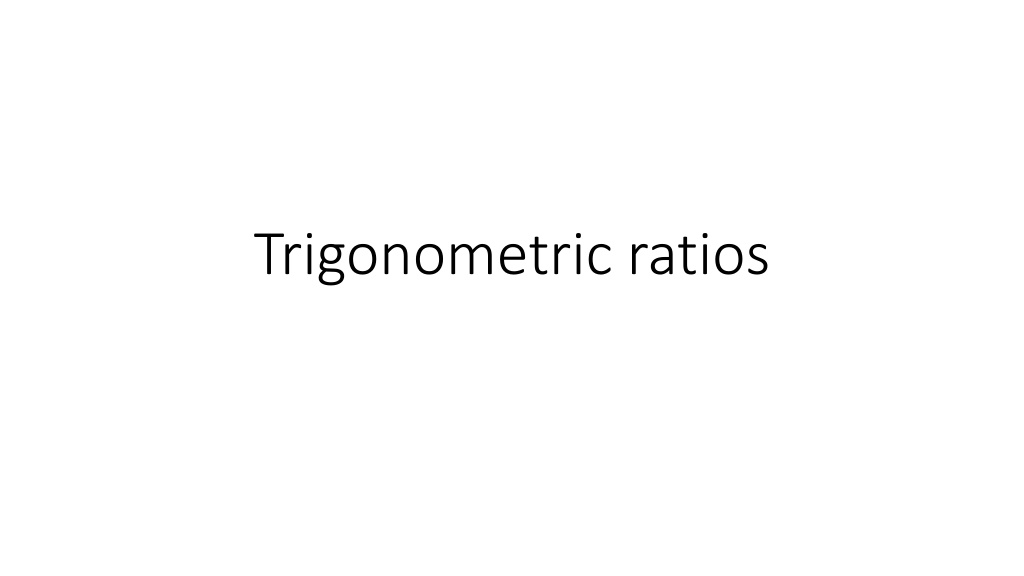Understanding Trigonometric Ratios in Right Triangles
Learn about trigonometric ratios like sine, cosine, and tangent in right triangles, and how to find side lengths and solve real-world problems using these ratios. Understand the AA Similarity Postulate and how to write trigonometric ratios as fractions and decimals. Dive into examples and exercises to sharpen your skills in trigonometry.
Download Presentation

Please find below an Image/Link to download the presentation.
The content on the website is provided AS IS for your information and personal use only. It may not be sold, licensed, or shared on other websites without obtaining consent from the author. Download presentation by click this link. If you encounter any issues during the download, it is possible that the publisher has removed the file from their server.
E N D
Presentation Transcript
Warm Up Write each fraction as a decimal rounded to the nearest hundredth. 1. 0.67 2. 0.29 Solve each equation. 3. 4. x = 7.25 x = 7.99
Objectives Find the sine, cosine, and tangent of an acute angle. Use trigonometric ratios to find side lengths in right triangles and to solve real-world problems.
Vocabulary trigonometric ratio sine cosine tangent
By the AA Similarity Postulate, a right triangle with a given acute angle is similar to every other right triangle with that same acute angle measure. So ABC~ DEF~ XYZ, and . These are trigonometric ratios. A trigonometric ratio is a ratio of two sides of a right triangle.
Writing Math In trigonometry, the letter of the vertex of the angle is often used to represent the measure of that angle. For example, the sine of A is written as sin A.
Example 1A: Finding Trigonometric Ratios Write the trigonometric ratio as a fraction and as a decimal rounded to the nearest hundredth. sin J
Example 1B: Finding Trigonometric Ratios Write the trigonometric ratio as a fraction and as a decimal rounded to the nearest hundredth. cos J
Example 1C: Finding Trigonometric Ratios Write the trigonometric ratio as a fraction and as a decimal rounded to the nearest hundredth. tan K
Check It Out! Example 1a Write the trigonometric ratio as a fraction and as a decimal rounded to the nearest hundredth. cos A
Check It Out! Example 1b Write the trigonometric ratio as a fraction and as a decimal rounded to the nearest hundredth. tan B
Check It Out! Example 1c Write the trigonometric ratio as a fraction and as a decimal rounded to the nearest hundredth. sin B
Example 2: Finding Trigonometric Ratios in Special Right Triangles Use a special right triangle to write cos 30 as a fraction. Draw and label a 30 -60 -90 .
Check It Out! Example 2 Use a special right triangle to write tan 45 as a fraction. Draw and label a 45 -45 -90 . 45 s 45 s
Example 3A: Calculating Trigonometric Ratios Use your calculator to find the trigonometric ratio. Round to the nearest hundredth. sin 52 Caution! Be sure your calculator is in degree mode, not radian mode. sin 52 0.79
Example 3B: Calculating Trigonometric Ratios Use your calculator to find the trigonometric ratio. Round to the nearest hundredth. cos 19 cos 19 0.95
Example 3C: Calculating Trigonometric Ratios Use your calculator to find the trigonometric ratio. Round to the nearest hundredth. tan 65 tan 65 2.14
Check It Out! Example 3a Use your calculator to find the trigonometric ratio. Round to the nearest hundredth. tan 11 tan 11 0.19
Check It Out! Example 3b Use your calculator to find the trigonometric ratio. Round to the nearest hundredth. sin 62 sin 62 0.88
Check It Out! Example 3c Use your calculator to find the trigonometric ratio. Round to the nearest hundredth. cos 30 cos 30 0.87
The hypotenuse is always the longest side of a right triangle. So the denominator of a sine or cosine ratio is always greater than the numerator. Therefore the sine and cosine of an acute angle are always positive numbers less than 1. Since the tangent of an acute angle is the ratio of the lengths of the legs, it can have any value greater than 0.
Example 4A: Using Trigonometric Ratios to Find Lengths Find the length. Round to the nearest hundredth. BC is adjacent to the given angle, B. You are given AC, which is opposite B. Since the adjacent and opposite legs are involved, use a tangent ratio.
Example 4A Continued Write a trigonometric ratio. Substitute the given values. Multiply both sides by BC and divide by tan 15 . BC 38.07 ft Simplify the expression.
Caution! Do not round until the final step of your answer. Use the values of the trigonometric ratios provided by your calculator.
Example 4B: Using Trigonometric Ratios to Find Lengths Find the length. Round to the nearest hundredth. QR is opposite to the given angle, P. You are given PR, which is the hypotenuse. Since the opposite side and hypotenuse are involved, use a sine ratio.
Example 4B Continued Write a trigonometric ratio. Substitute the given values. 12.9(sin 63 ) = QR Multiply both sides by 12.9. 11.49 cm QR Simplify the expression.
Example 4C: Using Trigonometric Ratios to Find Lengths Find the length. Round to the nearest hundredth. FD is the hypotenuse. You are given EF, which is adjacent to the given angle, F. Since the adjacent side and hypotenuse are involved, use a cosine ratio.
Example 4C Continued Write a trigonometric ratio. Substitute the given values. Multiply both sides by FD and divide by cos 39 . FD 25.74 m Simplify the expression.
Check It Out! Example 4a Find the length. Round to the nearest hundredth. DF is the hypotenuse. You are given EF, which is opposite to the given angle, D. Since the opposite side and hypotenuse are involved, use a sine ratio.
Check It Out! Example 4a Continued Write a trigonometric ratio. Substitute the given values. Multiply both sides by DF and divide by sin 51 . Simplify the expression. DF 21.87 cm
Check It Out! Example 4b Find the length. Round to the nearest hundredth. ST is a leg. You are given TU, which is the hypotenuse. Since the adjacent side and hypotenuse are involved, use a cosine ratio.
Check It Out! Example 4b Continued Write a trigonometric ratio. Substitute the given values. ST = 9.5(cos 42 ) Multiply both sides by 9.5. ST 7.06 in. Simplify the expression.
Check It Out! Example 4c Find the length. Round to the nearest hundredth. BC is a leg. You are given AC, which is the opposite side to given angle, B. Since the opposite side and adjacent side are involved, use a tangent ratio.
Check It Out! Example 4c Continued Write a trigonometric ratio. Substitute the given values. Multiply both sides by BC and divide by tan 18 . Simplify the expression. BC 36.93 ft
Check It Out! Example 4d Find the length. Round to the nearest hundredth. JL is the opposite side to the given angle, K. You are given KL, which is the hypotenuse. Since the opposite side and hypotenuse are involved, use a sine ratio.
Check It Out! Example 4d Continued Write a trigonometric ratio. Substitute the given values. Multiply both sides by 13.6. JL = 13.6(sin 27 ) JL 6.17 cm Simplify the expression.
Example 5: Problem-Solving Application The Pilatusbahn in Switzerland is the world s steepest cog railway. Its steepest section makes an angle of about 25.6 with the horizontal and rises about 0.9 km. To the nearest hundredth of a kilometer, how long is this section of the railway track?
Example 5 Continued Understand the Problem 1 Make a sketch. The answer is AC. 0.9 km
Example 5 Continued Make a Plan 2 is the hypotenuse. You are given BC, which is the leg opposite A. Since the opposite and hypotenuse are involved, write an equation using the sine ratio.
Example 5 Continued Solve 3 Write a trigonometric ratio. Substitute the given values. Multiply both sides by CA and divide by sin 25.6 . CA 2.0829 km Simplify the expression.
Example 5 Continued Look Back 4 The problem asks for CA rounded to the nearest hundredth, so round the length to 2.08. The section of track is 2.08 km.
Check It Out! Example 5 Find AC, the length of the ramp, to the nearest hundredth of a foot.
Check It Out! Example 5 Continued Understand the Problem 1 Make a sketch. The answer is AC.
Check It Out! Example 5 Continued Make a Plan 2 is the hypotenuse to C. You are given AB, which is the leg opposite C. Since the opposite leg and hypotenuse are involved, write an equation using the sine ratio.
Check It Out! Example 5 Continued Solve 3 Write a trigonometric ratio. Substitute the given values. Multiply both sides by AC and divide by sin 4.8 . AC 14.3407 ft Simplify the expression.
Check It Out! Example 5 Continued Look Back The problem asks for AC rounded to the nearest hundredth, so round the length to 14.34. The length of ramp covers a distance of 14.34 ft. 4
Lesson Quiz: Part I Use a special right triangle to write each trigonometric ratio as a fraction. 1. sin 60 2. cos 45 Use your calculator to find each trigonometric ratio. Round to the nearest hundredth. 3. tan 84 4. cos 13 9.51 0.97
Lesson Quiz: Part II Find each length. Round to the nearest tenth. 5. CB 6.1 16.2 6. AC Use your answers from Items 5 and 6 to write each trigonometric ratio as a fraction and as a decimal rounded to the nearest hundredth. 7. sin A 8. cos A 9. tan A























